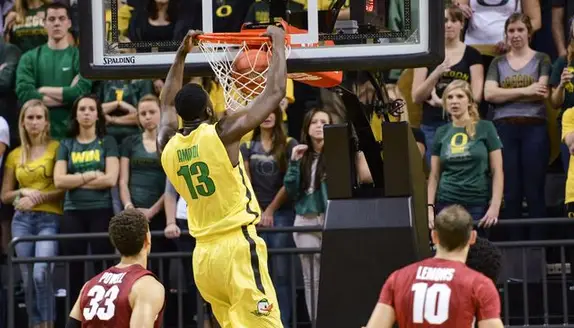Nobody likes their opponent. Ducks’ players shake the opposing team’s hands at the end of every game as a show of sportsmanship, but is the common fan convinced there isn’t at least an ounce of animosity present? The opponent’s job, goal and sole purpose is to defeat Oregon. And in that, they are evil by nature and in practice. The opponent is, in essence, wicked.
So how can the Oregon men’s basketball team resist and overcome the opponent? Like many teams before them, the Ducks look for help from one of the most prolific quick-plays in sports history — the ‘pick-and-roll.’
A pick-and-roll is a nifty two-man play where a player sets an on-ball screen, which we mentioned in a previous analysis, then rolls toward the basket looking for a pass.
Oregon doesn’t run the pick-and-roll every play like Stockton and Malone or Nash and Stoudemire used to, but only in certain situations. They run the pick-and-roll when they absolutely have to; when the opponent is being especially malicious and they need to be picked apart.
The Pick-and-Roll
The pick-and-roll begins with an on-ball screen. As seen above, center Waverly Austin has set himself in a strong stance between teammate Johnathan Loyd and his defender — thus initiating the pick. Loyd’s defender must now choose to either go under the screen, over the screen, or stick with Austin. If he goes under, Loyd may get an open jumper. If he goes over, Loyd may get an open lane to the hoop. And if he switches to Austin, two mismatches are created where Loyd has a speed advantage over Austin’s defender and Austin has a size advantage over Loyd’s defender.
In this case Loyd’s defender chooses to go over the screen. By the time this opponent has gone around Austin, several clever actions were committed. First, Loyd notices his defender’s decision to follow him (foolishly), so he attacks the basket where Austin’s defender (highlighted in green) is now forced to help. Meanwhile, Austin is cutting toward the basket with his eyes on Loyd in hopes of a pass — thus initiating the roll. Both Austin’s and Loyd’s defenders are primarily focused on stopping Loyd’s drive, while forgetting about the big man heading full steam into the key.
Loyd then capitalizes on the opponent’s toxic mistake by making a quick bounce pass to Austin. This passing lane is made possible by the gap between Loyd and Austin’s defenders. Austin will now look to take the rock to the rim with reckless abandon for the well-deserved two points. And there we see the genius of the pick-and-roll.
But, what if a player has the ability to shoot as well as drive to the hoop? Enter forward Mike Moser. Occasionally when he, or other confident shooters, set high picks they commence the pick-and-pop. This move is much like a pick-and-roll except instead of the screener rolling to the basket, they open up for a pass that should theoretically lead to an open jumper.
The Pick-and-Pop
Like the pick-and-roll, the pick-and-pop begins with an on-ball screen, as seen above. Mike Moser is providing a terrific screen for Johnathan Loyd, forcing Loyd’s defender to make a decision similar to the one he made in the previous example.
Learning from his mistake in the first example, Loyd’s defender decides to switch and stick with Moser. Moser responds by popping off of Loyd’s defender and out to the wing in hopes of a pass for a jumper — thus initiating the pop. His movement to the wing not only creates space for Loyd to make a play, but frees him up for a possible jump shot over the shorter defender.
Moser has successfully navigated to the wing and is relatively open. Time is running out however, so Loyd decides to pull-up for a J over the slower defender. Unfortunately, he uncharacteristically misses the mark this time. But on the next Oregon pick-and-pop look for Moser, or whoever, to knock down that sweet 3.
The point of the pick-and-roll and the pick-and-pop is obvious — to pick apart that wicked opponent. The results are proven and the execution is easy, so anytime an opponent gets out of line with some hard-nosed D, punish them, like our beloved Ducks do, with a quick pick-and-roll. Of course, it helps to have a heroic point guard such as Johnathan Loyd as the ball handler, but with analyses like these, mastery is simple.
Basketball is, simply, a complicated sport.
Lawrence Hastings spent the first fifteen years of his life in Los Angeles, California before moving to Eugene, Oregon. Transitioning to Duck land was easy for him seeing as he was raised a Pacific Conference fan since birth. So Lawrence, loving his new green home, chose to pursue a Sports Business degree at the University of Oregon. In his spare time Lawrence plays and watches sports religiously, with a particular passion for basketball. His favorite Duck of all time is Aaron Brooks, whom he met at local basketball camp as a teenager.










